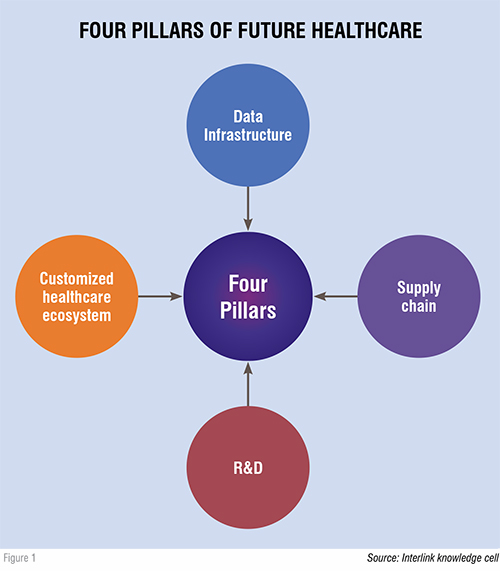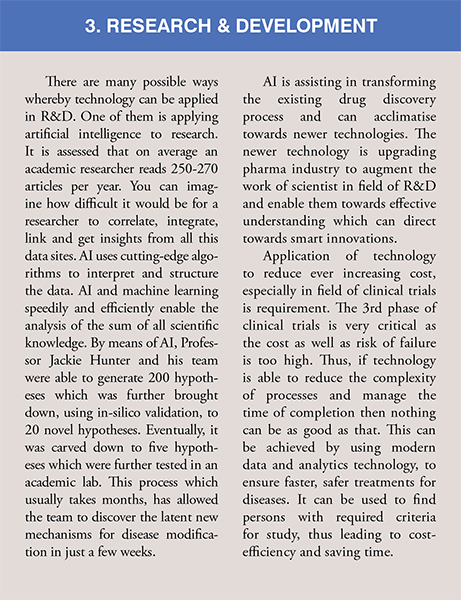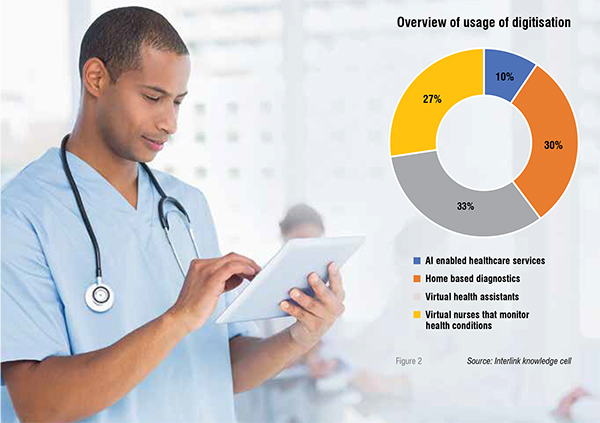Healthcare digital transformation is rapidly taking its hold on the industry. The primary focus is to provide patient satisfaction. With paradigm shift from paper driven industry to digitally advanced industry, primary healthcare services are more focused towards patient centric care and has evolved with contribution of smart devices, Internet of Things, Data analytics and Artificial intelligence. As per new research, Asia-pacific is showing 14 per cent-21 per cent of improvement in patient outcomes and disease prevention due to digital transformation. Digital transformation is a journey which aims to integrate elements of web, social, mobile, AI, analytics, cloud and other technologies to enhance customer experience and develop organisational competitive excellence.
Emerging technologies are moulding healthcare services in multiple ways to provide accessibility, availability at affordable costs. Thus, it is looking at how consumers access it, how and which providers deliver it and what health outcomes are achieved. Looking at spurt of digitisation across globe, the emerging technologies like connected and cognitive health devices, electroceuticals, targeted and customised medicines, robotics, 3-D printing, big data and analytics, artificial intelligence, blockchain, and robotic process automation are gaining a grip on market. It seems like in the near future, digital transformation in healthcare could be applied at four levels: data infrastructure, efficientsupply chain, R&D, and customised healthcare ecosystem.Fig.1
In this process of digitisation, it is estimated that by 2020, the number of connected devices across the globe will be nearly 50 billion. Thus, the need to manage big data and further analysing it would be very critical. This data is important as it would consist of potential insights and patterns that can improve decisions. It has been claimed by healthcare providers that electronic health records (EHRs)have the ability to improve quality and safety, and improving management of health information and clinical data. It provides accurate, up-to-date and complete information about patients at the point of care, thus enabling quick access to patient records for more efficient care. These also help experts understand disease trends for better diagnosis. Also, from the patients’ perspective, it enables improved services and reduces redundant clinical tests.
The patient data generated across various hospital departments is the most valuable raw data, that can be further used for the analysis of national health. This data can also be employed to develop the future services based on the need. This includes data like patient habits, pattern of use, frequency of drug dosages, health history, and adverse reactions. This helps to understand the tolerance and effects of drug, which in turn, helps to drill down the understanding of knowledge that can clear the way for new R&D initiatives.
Hospitals currently spend approximately 45 per cent of their operating budgets on supplies and materials and industry experts expect that hospitals will spend more on supply chain management than labor costs in near future. Thus, it is expected that supply chain digitisation will be an emerging field in healthcare. This will eventually reduce manpower, especially lower ranking medical professionals, as their job roles will be taken up by apps and wearables. Even at present, apps can signal the need of refilling the prescription medication or inform doctors of health changes or if any modification of drugs has to be done, indirectly accelerating the drug supply chain. Investing in electronic inventory tracking system will enable transfer of data on medical supplies and allow hospitals to automate the inventory replenishment process.

Blockchain technology, known for its secure, wide range of database distribution, is well suited in supply chain management, serialisation, identity management, transaction processing, contract and licensing management, and documentation management. This technology ensures integrity of data amongst the stakeholders in the industry. A blockchain-powered health information exchange is capable of unlocking the true value of interoperability and can directly reduce the cost of current intermediaries.
Case study: BJC Healthcare, one of the nation’s largest non-profit healthcare organisations located in the Midwest, US, was awarded in 2015 by Gartner, a global research and advisory company, for the its efforts in supply chain digitalisation. The organisation has invested in technology that confers radio frequency identification (RFID) tags to medical devices. This enabled the automation of inventory replenishment, leading to 23 per cent reduction of required inventory. In fact, they also saved costs by avoiding product expiry and reduced labour costs of nurses and clinicians by decreasing time spent on inventory management.

Today, data from various medical devices as well as from preventive wearables is used to adjust drug and treatments precisely based on the patient requirement. AI in R&D is not only about producing new drug formulations for patients, but it’s also a matter of how the AI platform will access the patient’s medical records, genetic markers, analyse data from wearables, and how well it will predict the health conditions before they become serious. In this case, AI is enabling customised medicines to behave proactively. 3-D printers are already employed in production of drugs, and now they are looking to apply technology in printing organs. No doubt, the company that is successful in applying these technologies will enjoy competitive advantage. Aprecia Pharmaceutical has applied 3-D printing to produce pills that are easy to swallow for every age group.
Starting from secondary research to find new links between genetic codes to robotic surgeries, AI is reinventing and reinvigorating healthcare services through modern technology that can analyse, predict, comprehend learn and act accordingly. In Germany, 54 per cent of companies have already implemented analytics. Even automation of supply chain is enabled to increase efficiency. Further, now they are looking to apply predictive analytics in production planning.
The main idea behind this approach is to develop a patient-friendly environment whereby patients are equal partners in planning, developing, and monitoring healthcare. In the past, patients were given appointment as per the availability of healthcare service providers. Now, the whole healthcare system is running around a patientcentric approach. Digitisation has emerged one of the tools to achieve goals of excellent healthcare system. Digitisation across healthcare has provided various significant approaches to share information on quality, costs and outcomes leading to connected health.
The connected health approach is the most crucial part of the patient flow. The objective of connected health is to connect the healthcare delivery system by means of information technology to enable access and sharing of data across healthcare providers to allow analysis as and when required by the patient or the healthcare authority.
According to study done by Accenture, Consumer use of mobile and tablet health apps has tripled over the past four years, from 16 per cent in 2014 to 48 per cent today, as part of a growing digital revolution in healthcare. As per the dipstick study, which surveyed 2,301 consumers, the percentage of consumers that are sharing the personal data willing to share with their insurance carrier personal data collected from their wearable devices has increased over the past year, from 63 per cent in 2016 to 72 per cent today.

By providing to patients who are admitted or even after discharged, the hospital can take total care and provide a delightful experience. Looking at the recent developments in healthcare, such events can be bifurcated into various segments depending on their applications. The main objective of development is to improve the healthcare services and provide patient satisfaction. In reality, the hospital administrator should consider digitisation as an innovative measure that not only needs installation but also needs change of mindset with digital processes. In the recent course of the transformation, significant digitisation would be observed in the area of customised healthcare. This will ensure a patientcentric approach in which community medical services and social caregivers would also be integrated.
References:
1.Healthcare – Where Supply Chain Digitalization is Life or Death, Healthcare Enthusiast, November 15, 2017
2.Digitization of healthcare will upend its supply chain, SUPPLYCHAINDIVE
3.Digitization in life sciences, Integrating the patient pathway into the technology ecosystem, KPMG